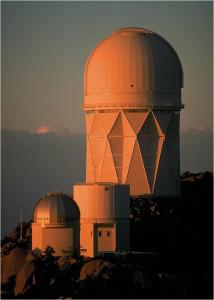Physics
The DESI Experiment at SMU
 In the very earliest universe, dark matter is believed to have
congregated in initial fluctuations in density, but baryonic matter, the
matter we see by light and are familiar with, was pushed away from these slight
dark matter concentrations by light until the universe cooled to approximately
3000 degrees K. We speak of this baryonic matter as ‘frozen’ at fixed separation
or distance scale at this point, and we can use the apparent size of this
distance scale over the age of the universe to probe how fast it is expanding.
We use galaxies to measure this distance scale, and this provides an extremely
powerful way to study dark energy at much larger distances from Earth than can be
examined via supernovae. The primary measurement of the DESI experiment is
this distance scale and its evolution, which will be used to test theories of
gravity and the birth and evolution of the universe. DESI itself is a next
generation system that will pack 5000 robotically positioned optical fibers
into the prime focus of the Mayall 4 m telescope at Kitt Peak National Observatory.
The survey is expected to achieve precise measurements of the expansion rate of the
universe and other cosmological parameters over an unprecedented range of redshifts
out to z = 3.5. The SMU group led by Kehoe is involved in the effort to develop
analysis techniques to accomplish this goal, including analysis of galaxy
clustering and the fast software designed to ensure DESI operations reach their
optimal design sensitivity.
In the very earliest universe, dark matter is believed to have
congregated in initial fluctuations in density, but baryonic matter, the
matter we see by light and are familiar with, was pushed away from these slight
dark matter concentrations by light until the universe cooled to approximately
3000 degrees K. We speak of this baryonic matter as ‘frozen’ at fixed separation
or distance scale at this point, and we can use the apparent size of this
distance scale over the age of the universe to probe how fast it is expanding.
We use galaxies to measure this distance scale, and this provides an extremely
powerful way to study dark energy at much larger distances from Earth than can be
examined via supernovae. The primary measurement of the DESI experiment is
this distance scale and its evolution, which will be used to test theories of
gravity and the birth and evolution of the universe. DESI itself is a next
generation system that will pack 5000 robotically positioned optical fibers
into the prime focus of the Mayall 4 m telescope at Kitt Peak National Observatory.
The survey is expected to achieve precise measurements of the expansion rate of the
universe and other cosmological parameters over an unprecedented range of redshifts
out to z = 3.5. The SMU group led by Kehoe is involved in the effort to develop
analysis techniques to accomplish this goal, including analysis of galaxy
clustering and the fast software designed to ensure DESI operations reach their
optimal design sensitivity.